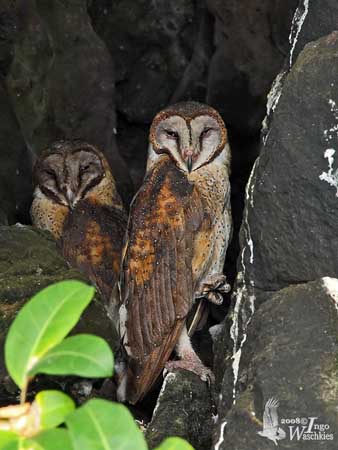
TO BE CONTINUED... Page 12
Text by Nicole Bouglouan
Photographers:
Roger Ahlman
Pbase Galleries Peru and Ecuador
Alfredo Colón
Puerto Rico Wildlife
Steve Garvie
RAINBIRDER Photo galleries & Flickr Rainbirder
Paul Guillet
Photos d’Oiseaux
Ken Havard
My Bird Gallery & Flickr gallery 1 & Flickr gallery 2
Patrick Ingremeau
TAMANDUA
Tom Merigan
Tom Merigan’s Photo Galleries
William Price
PBase-tereksandpiper & Flickr William Price
Alan & Ann Tate
AA Bird Photography
Ingo Waschkies
Bird Photography
Callie de Wet
GALLERY
Philippe Wolfer
OISEAUX D’ARGENTINE
These images and the text are subject to copyright and cannot be used without express authorization from the owners. Legal issues
Sources :
HANDBOOK OF THE BIRDS OF THE WORLD Vol 5 by Josep del Hoyo-Andrew Elliott-Jordi Sargatal - Lynx Edicions - ISBN: 8487334253
L’ENCYCLOPEDIE MONDIALE DES OISEAUX - Dr Christopher M. Perrins - BORDAS - ISBN: 2040185607
OWLS OF THE WORLD – By Claus König, Friedhelm Weick and Jan-Hendrik Becking - IBSN 978-0-7136-6548-2
Wikipedia, the free encyclopaedia
Bird nests: Variety is Key for the world’s avian Architects
Be on the lookout for bird nests
The design and function of birds' nests
Page under
copyright !
The bird and its nest, where everything starts…
Page 11: Tytonidae, Strigidae, Steatornithidae, Podargidae, Nyctibiidae, Caprimulgidae
At the beginning of the breeding season and following several courtship displays, the nest-site is selected by the pair, or one of the members of the pair, and the nest is built within this area. For numerous species, the nest is the place where displays and copulation occur. It plays a very important role during the nesting period. It is the cradle of the chicks, the place where the adults feed them prior to their first flight towards independence.
The members of the family Tytonidae usually have a rounded head with a heart-shaped facial disk. The tail is squared and the legs are fairly long. The strong feet are armed with powerful talons. They have cryptic plumage providing them an excellent camouflage. Females are larger than males. The juveniles are usually darker than adults until they reach their sexual maturity.

These birds are very well adapted to their nocturnal behaviour, thanks to both shape and composition of feathers of the facial disk, the asymmetrical ears and their keen eyesight due to the large eyes.
These owls frequent rainforest, forest-edges, wooded farmland, swamps, mangrove edges, lowlands with scattered trees. Their habitat must be suitable for hunting and nesting.
They are almost all nocturnal birds, living alone or in pairs. They often are sedentary and occupy their territory all year round and over several years.
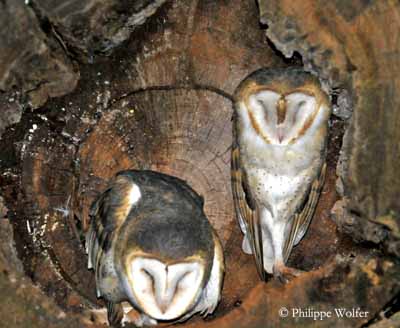
Several weeks before the laying, the males call frequently at potential nest-sites at night to attract females. They also perform display flights while calling, making short flights over the area. They may offer food to the female during the courtship displays.
These owls nest in natural cavities, often in trees, but some species nest on the ground, in abandoned burrows, among the clutches of grass. They also use artificial structures, according to nest-site availability.
The male hunts and feeds both female and the young. The fledging period varies with the species from 42 days to 60, 84 or 90 days.
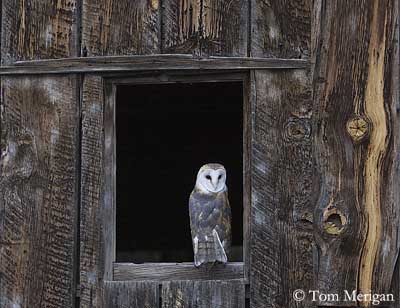
The typical owls of family Strigidae have large head with circular facial disks and large elongated eyes. Many species exhibit conspicuous ear tufts, and we can see sometimes two dark patches on the nape, similar to false eyes. The cryptic colours of these owls allow them to be almost invisible when they rest in trees during the day. The female is usually larger than male.
The large, elongated eyes positioned well apart on the face give them a very good depth perception. They also show important asymmetry in ear size, allowing them to detect the prey only by the sound.
Most species live in forested habitats where they find food and nest-sites, with the higher numbers in tropical forests.
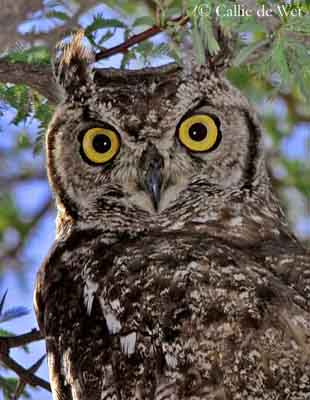
Most owl species are nocturnal and perform silent flight thanks to the soft flight feathers. On the other hand, some birds such as Glaucidium, Ketupa and Scotopelia owls are largely diurnals and their flight is not as quiet as that of nocturnal birds.
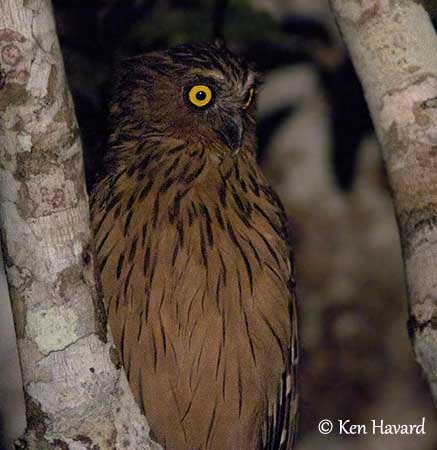
During the breeding season, the male utters vocalisations during one month before the nesting period, in order to attract a female or to renew the pair-bond with its mate. Courtship feeding is often observed, with female begging food as a young bird, and male performing wings and body displays prior to copulation.
At nest entrance
Some species, such as the Burrowing Owl, live underground in burrows, but usually, they nest in abandoned twig nests, in tree cavities, on cliff ledges, mounds or platforms. They may use artificial nest-boxes.
The female performs all of the incubation and nesting duties, while the male hunts and feeds the family, transferring the prey to the female which then feeds the chicks. The juveniles perform post-breeding dispersions when they become independent.
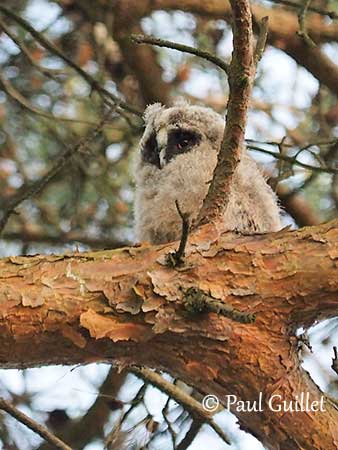
Chick
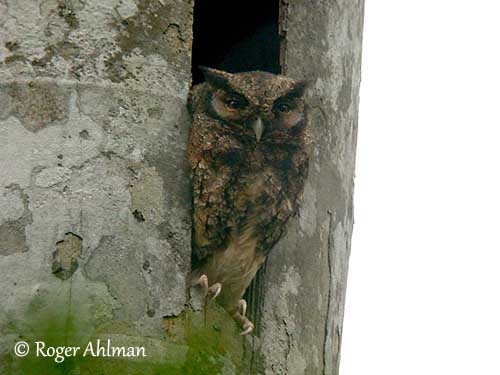
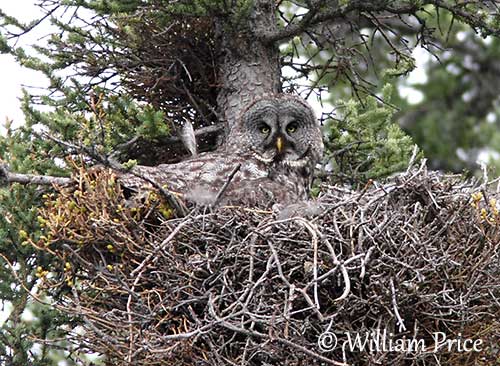
There is only one member in the family Steatornithidae, the Oilbird, which is found in some regions of N and NW South America. It has reddish-brown plumage with narrow black bars and scattered white spots on long tail, wings, head, nape and breast. The underparts are paler. Tail feathers are stiff. Wings are broad and long.
The head is slightly paler with fine white spots. The powerful beak is hooked and blackish. It has very developed stiff rictal bristles. The eyes are yellowish to reddish-brown. Short legs and small feet are pale reddish-brown. The legs are placed far forwards.
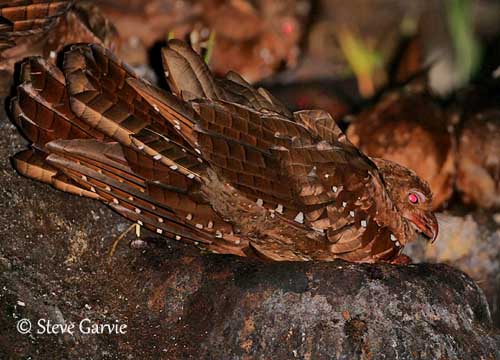
The Oilbird is a nocturnal bird which navigates by echolocation, also called biosonar. The bird utters calls and listens to the echoes in order to locate or identify objects. It lives on rocky ledges in caves during the day, but it needs evergreen lowlands and montane forests to feed year round.
It feeds on fruits, mainly of the Oil Palm (genus Elaeis) and tropical Laurels. It forages by sight. It uses its strong bill to pluck fruit while hovering in the air. This bird never perches except in the caves.
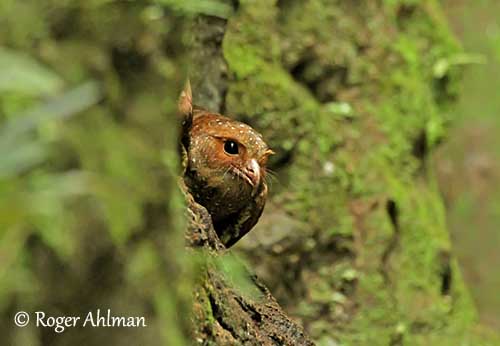
The Oilbird breeds in caves, at places without any penetrating daylight. They breed in total darkness and in colonies. This species is strongly gregarious, with colonies of up to 10 000 birds. They spend the day sitting on their nests or perched on rocky ledges.
The nest is placed on a ledge, about 10-20 metres above the cave’s floor. Sometimes, they may nest on the ground.
The nest is made with regurgitated plant fibres, compacted into a firm paste. It is a cylindrical mound of about 40 centimetres in diameter. They nest in large colonies, often at good distance into the cave.
The altricial chicks are fed by both adults with oil-fruits. They grow slowly and leave the nest about 110-120 days after hatching.
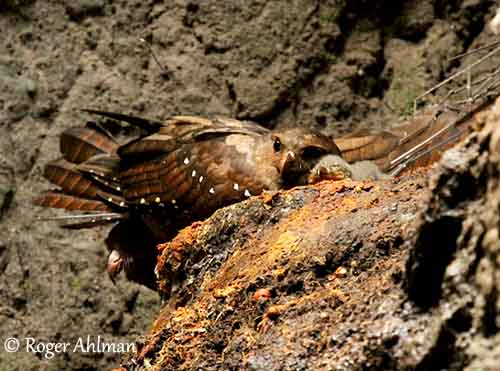
Adult on the nest with chick
The family Podargidae includes two genera only known in the Australasian region (genus Podargus) and in the Oriental, Indo-Malayan Region (genus Batrachostomus).
There are small to large, stocky birds with strong, large bill and short legs. The very wide bill is the most obvious feature used to define this family, and gives the birds the name “frogmouth”. The nostrils are hidden by long rictal bristles.
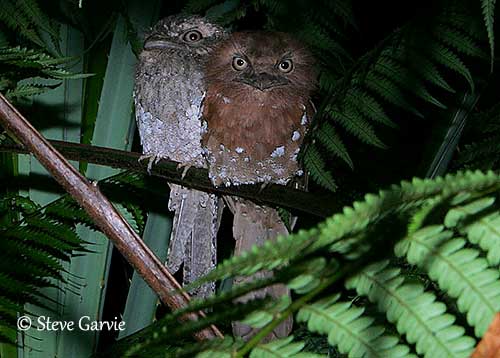
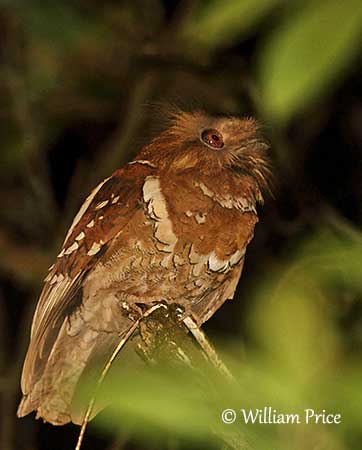
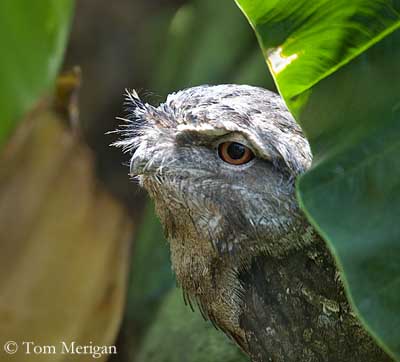
When perched, these nocturnal species adopt an upright stance. They frequent primarily forest or woodland, wooded savanna and dry scrub. They are usually found at low elevations, although some species may reach up to 2,250 metres.
They feed mainly on large insects, but other prey such as spiders, myriapods, scorpions, crustaceans, earthworms, and occasionally slugs and snails are also part of their diet. However, small vertebrates including frogs, lizards, small rodents and sometimes small birds are taken by Podargus species.
They hunt mainly by sallying from prominent perch to catch moving insects and other prey. The food items are taken from the ground, but mainly from tree trunks, branches or foliage. The prey is caught with the bill. Some flying prey can be caught on the wing.
The frogmouths build well-formed nests, often placed on tree branches, shrubs, or on top of epiphyte, but abandoned nests by other bird species may also be used.
Sri Lanka Frogmouth
Pair
Male rufous morph and grey female
The nest structure differs considerably between the two genera of this family.
The genus Podargus builds a bulky to rather small platform with a shallow cup, made with criss-crossed twigs, sticks, vine tendrils or stems. There is sometimes addition of grass, leaves, moss or lichen.
The nest structure of genus Batrachostomus is poorly known, but these species seem to build a very small, neat, firm cup with interwoven down from the bird’s underparts. Some spider webs, mosses, lichens or leaves can be added on the outside, in order to make the nest invisible.
Both adults build the nest. The clutch includes 1-2 eggs and both mates incubate, the male during the daytime and the female at night. They also feed the chicks at nest, but the young are still fed by their parents after leaving the nest for one or two weeks. They remain in family group during several months.
The potoos of the family Nyctibiidae are endemic to the Neotropics, and are primarily found in the Amazonian lowlands. They differ from other families by the “toothed” bill with short culmen and wide gape, and the tooth-like projection positioned on each side of the tip of the bill. They lack the rictal bristles, although some thin bristles occur in the loral area between the eye and the nostril.
Their very large eyes adapted to life at night, reflect a strong red or orange glow in a beam of light. Another peculiar feature is the upper eyelid which shows two or three small folds along the edge, creating notches or slits, and allows the bird to detect potential movement or danger while roosting, although having the eyes closed. The short legs and the small, weak feet are only used for perching on branches, and the fleshy pads on the underside of the toes are probably an adaptation to this behaviour.
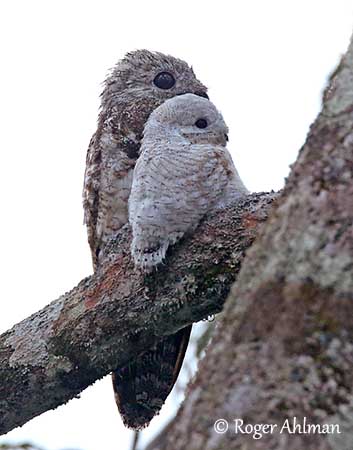
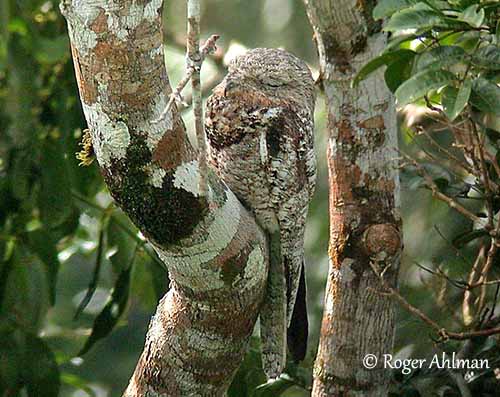
As nocturnal species, the potoos roost during the day, perched in trees on horizontal branches or more often at top of broken stub in exposed places or in the canopy. The bird is alone, perched in upright stance with its eyes closed, the head is tucked into the shoulders and the body feathers are loose. The cryptic plumage looks like the tree bark and is similar to a dead stump or branch.
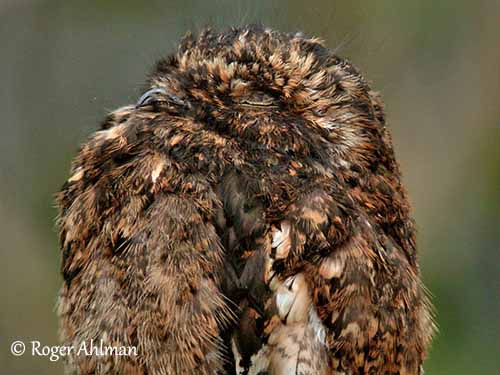
All potoos are forest birds and are found in dense humid forest, but some of them may occur in drier forest or in low vegetation with scattered patches of trees. Generally, they can be flexible in their habitat selection, but with some preferred habitat types including forest.
The potoos do not build a nest. They use a natural depression on a branch in tree, often a scar left by a fallen broken branch, or at top of broken stub. Only a hollow without additional nest material is used for the egg. The egg disappears completely under the feathers of the adult’s belly.

Incubating adult
Later, the chick is in the same position, both adult and chick facing in the same direction. The chick is visible only when it is fairly large, but it remains against the adult’s feathers.
These birds are monogamous and both adults share all the nesting duties.
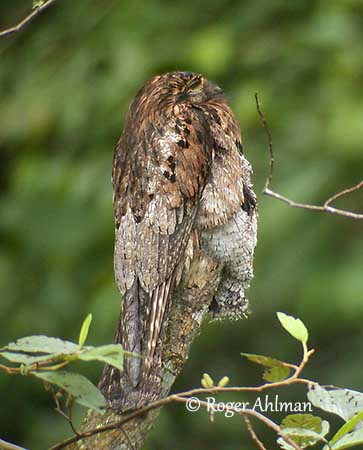
With chick
With chick under belly's feathers
The family Caprimulgidae includes two types of birds, the nighthawks and the typical nightjars. They differ by some features such as shape of palate, and the nighthawks generally lack the elongated rictal bristles around the gape and are usually more active during the day than nightjars.
They are medium-sized nocturnal species with cryptic plumage, large mouth, long wings and tail and short legs. They can be found in all countries and continents, but they are absent from the polar regions. They frequent desert, grassland and open wooded country to forest, and can be seen up to 4,200 metres of elevation, depending on the range.
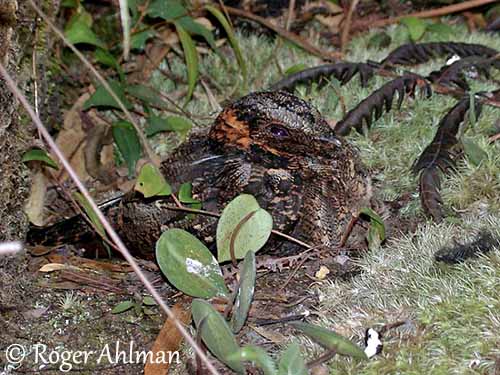
Female on the nest
They are insectivorous and take primarily night-flying, winged insects caught and swallowed in flight. However, numerous species also catch insects from leaves, branches and even from the ground. They take prey of all sizes. They forage mainly at dusk and dawn with very agile flight while pursuing prey.
As nocturnal species, the breeding behaviour is difficult to study. Nightjars are usually territorial and monogamous with long-term pair-bonds. They nest on the ground, within the territory defended by the male. They usually nest in dry, open areas, and the nest-site is often near or among vegetation, rocks, stones or fallen branches offering some protection against bad weather and predators.
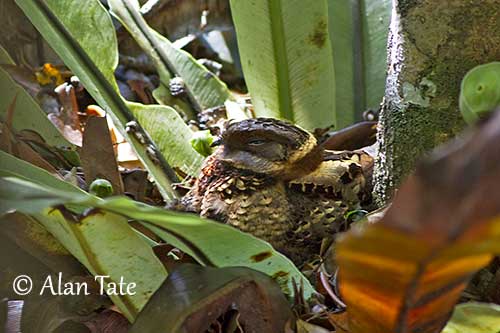
Adult at nest
They do not build nest and the 1-2 eggs are laid directly on the ground, on the leaf litter, on bare soil, gravel or sand. Some chicks may remain in the vicinity of the nest-site until they fledge, whereas others move long distances (10-20 metres) and change location each night. They are fed by regurgitation, a ball-shaped food directly into the mouth. They become independent at about 25-32 days after hatching, and in many species, the young remain in family groups for several weeks.
Eggs laid on the ground
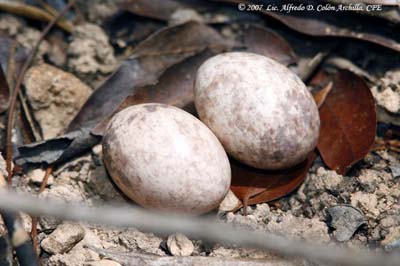
Adult at nest
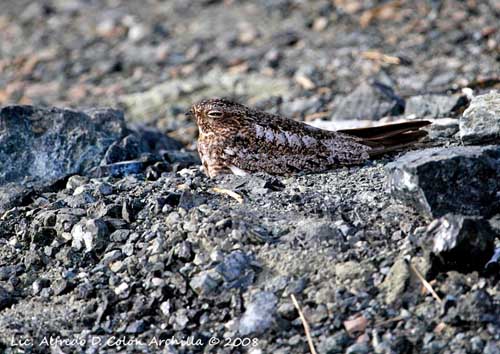
Adult with chick
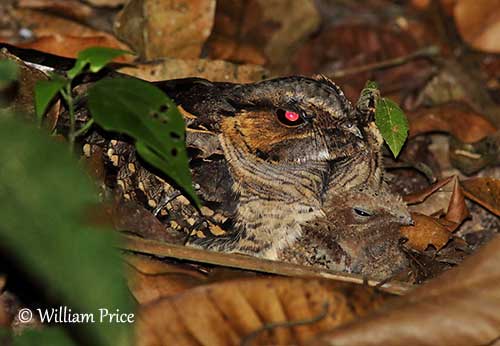
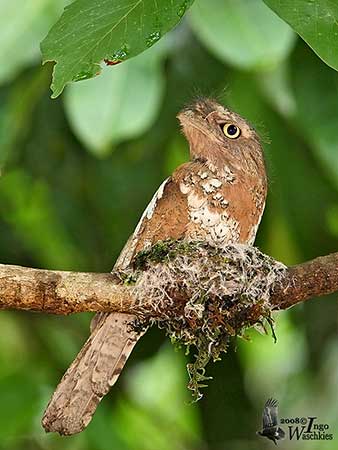
Javan Frogmouth
On the nest